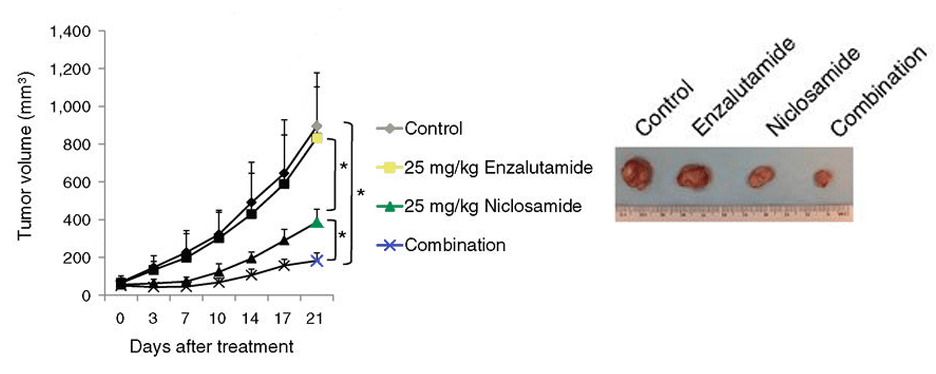Prostate cancer. Among the most common tumours in men, prostate malignancy is generally considered a slowly growing condition, which for many years remains without symptoms and metastasis. However, advanced disease could become life-threatening, therefore, every stage prostate cancer should be controlled for the rest of the life to keep progression at bay.
The fact that niclosamide suppresses AR-V7 (androgen receptor-splice variant 7) may open up a closed door back to a lot of treatment options when prostate cancer becomes resistant to all available medicines. [1]
Additionally, by blocking STAT3 (signal transducer and activator of transcription 3) the anthelmintic drug decreases the likelihood of tumours progressing, becoming more aggressive as well as spreading. [2]
Last but not least, niclosamide shifts the intracellular-extracellular acidity balance in cancer, which reactivates apoptosis (programmed cell death). This decreases the size of the tumour and prevents it from expanding further. [3]
These are not the only ways in which this anthelmintic could prove to be useful. Interestingly, by downregulating the AR-V7 protein niclosamide does not only reverse enzalutamide and abiraterone resistance in treating prostate cancer, but it also simultaneously enhances the effects of these medications. [4]
In 2018 a phase I clinical trial on niclosamide in combination with hormonal therapy against metastatic prostate cancer was finished. The study concluded that, although, niclosamide looks promising, bigger doses perorally may be needed to achieve a clinically significant effect. Doses between 500 mg – 1500 mg are generally well tolerated daily. [5] [6]
A more advanced phase II clinical trial is currently in progress to determine if novel systemic therapy with prednisone and niclosamide could be the key in shrinking metastatic prostate cancer in patients. [7] [8]
The current research suggests that niclosamide could be one of the missing pieces in controlling this type of cancer, especially in combination with conventional treatments.
At the end, one should also consider another powerful anthelmintic drug as an option for handling prostate cancer – fenbendazole. This drug works in a similar fashion like taxanes, the main line chemotherapy for prostate malignancies and can be safely taken together with niclosamide.
The difference between chemotherapy and these anthelmintic drugs is that the latter is more safe, does not cause strong toxicities and is relatively cheap. For this reason, in controlling cancer, niclosamide and fenbendazole can be taken for a long period of time, especially when combining with other protocols or traditional medicine therapeutic regimens.

Fig. 1. Comparison of enzalutamide (hormonal therapy) and niclosamide efficacy on treating prostate tumors in mice. As we can see, either treatment is quite effective on its own, however, when used in combination they exhibit an exceptionally strong synergistic effect. On the right, the size difference of the tumors that were removed after several weeks of different treatments is displayed. Retrieved from [9].